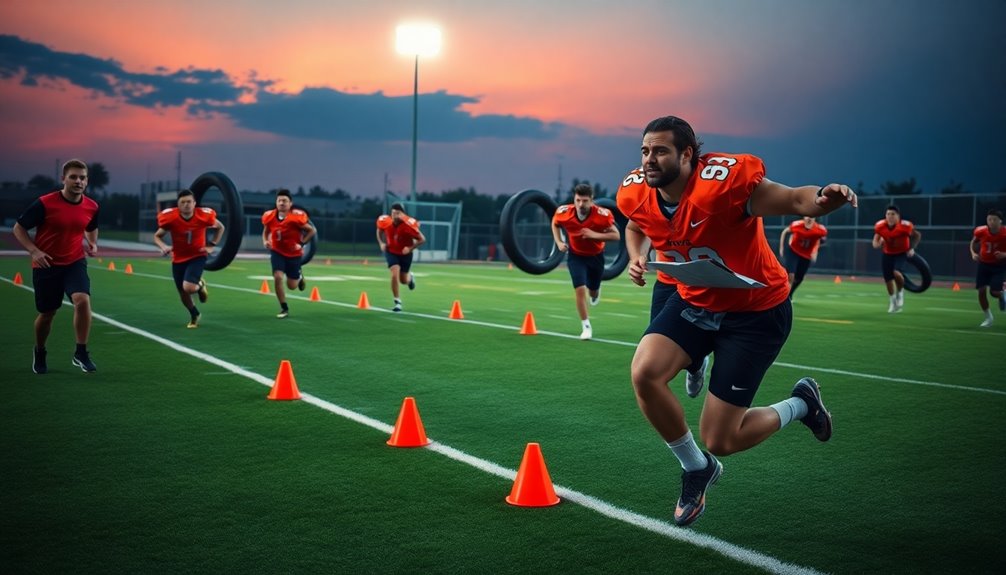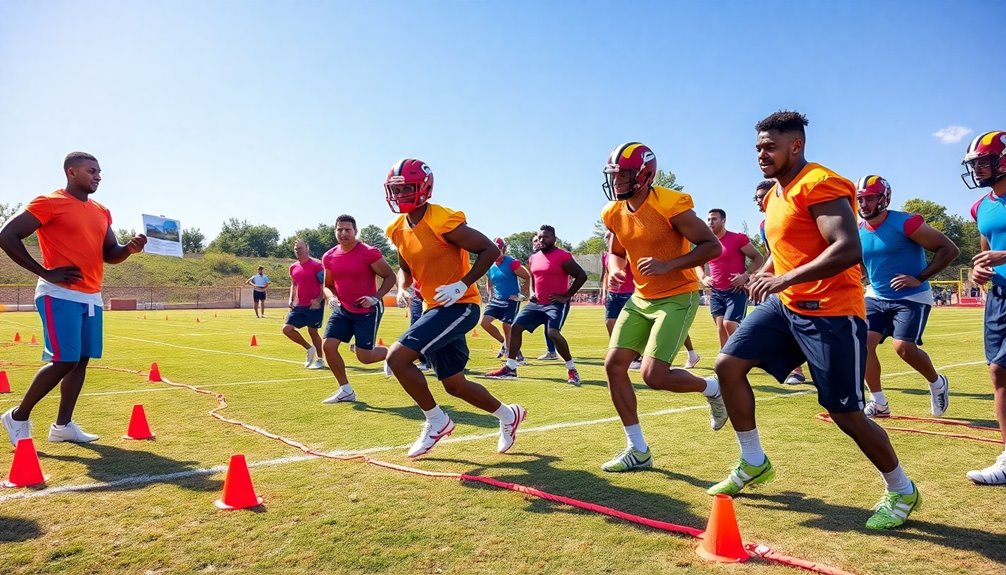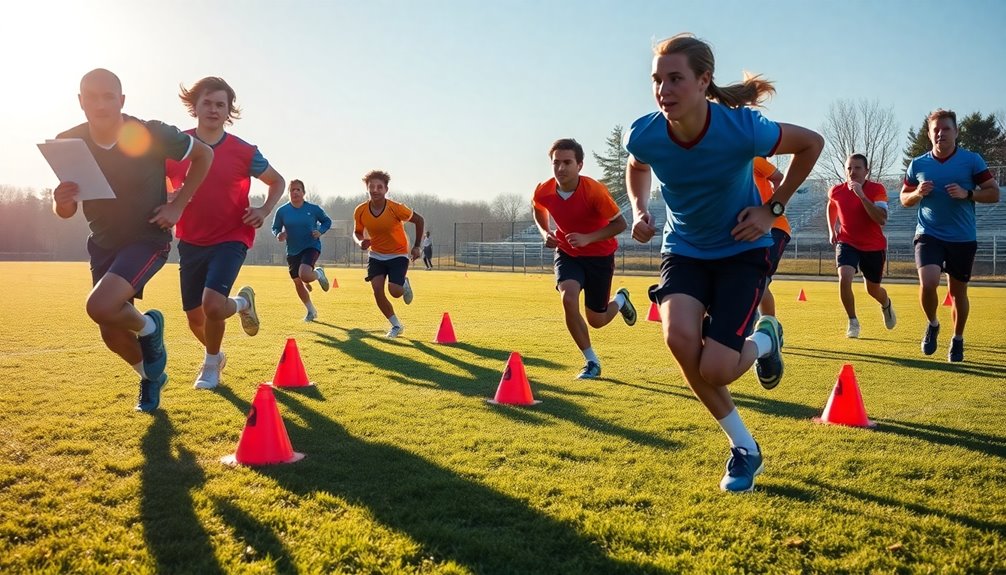
Conditioning Drills to Keep Football Players Game-Ready
January 25, 2025To keep football players game-ready, focus on essential conditioning drills that boost endurance, strength, and agility. Incorporate speed drills like sprint intervals and cone exercises to improve quickness. Use agility drills, such as T-drills and ladder work, to enhance footwork. Strength training through bodyweight exercises can build muscle resilience, while long-distance running helps maintain energy levels. Don't forget dynamic stretches to promote flexibility. Regularly assess fitness through tests like the 12-minute run or ABC 150s, adjusting your drills to fit your needs. There's so much more to learn about maximizing your training effectively!
Importance of Conditioning
When it comes to football, conditioning isn't just important—it's essential. As a football player, you know that enhancing your endurance, strength, flexibility, and agility directly impacts your performance on the field. Proper conditioning prepares you for the physical demands of the game, helping you navigate rapid speed changes and directional shifts with ease. Incorporating an effective conditioning program into your training routine isn't just about improving skills; it's also a key factor in injury prevention. By building your body's resilience through challenging drills, you reduce the risk of injuries, allowing you to stay in the game longer. Regular practice of speed and agility drills not only boosts your physical capabilities but also builds your confidence to withstand tough game conditions. Additionally, core strength exercises enhance your overall stability, further contributing to your performance. Moreover, good conditioning helps you maintain your health throughout the season. It allows for quicker recovery after intense matches, ensuring you can sustain high performance levels week after week. Engaging in drills like Pain Shuttles can significantly improve your cardiovascular endurance, preparing you for the demands of fast-paced gameplay.
Types of Conditioning Drills
Conditioning drills form the backbone of any football training program, directly translating to improved on-field performance. When you incorporate various types of football conditioning drills, you'll enhance your skills and readiness for game day.
Start with speed drills that help improve your quick acceleration and deceleration. Techniques like sprint intervals and cone drills boost your overall game speed.
Shifting to agility drills like T-drills and ladder drills is vital for developing your footwork and reaction time, allowing you to change directions swiftly during gameplay.
Don't overlook strength training, which includes bodyweight exercises and weightlifting. These build muscle power and resilience, critical for tackling and withstanding physical impacts on the field.
Also, endurance training through long-distance running and interval workouts prepares you for sustained performance, helping you maintain energy levels throughout the game.
Finally, flexibility routines such as dynamic stretching and yoga improve your range of motion and aid recovery, vital for preventing injuries. Incorporating targeted stretching of key muscle groups enhances muscle elasticity, supporting overall recovery.
Specific Conditioning Drills

To elevate your performance on the field, incorporating specific conditioning drills is essential. Start with the 4-on-4 Touch the Line Drill, which enhances your fitness and ball control by promoting constant movement and quick decision-making during gameplay. This drill simulates real-game situations, keeping you on your toes. Additionally, a proper dynamic warm-up routine is crucial to prevent injuries and maximize your performance.
Next, try the Pain Shuttles Drill. This involves sprinting between cones, emphasizing speed, agility, and rapid directional changes that are vital for football performance.
For foot speed and coordination, Ladder Drills offer various footwork patterns, greatly boosting your agility.
Don't overlook Hill Sprints; they build explosive power and leg strength while simulating the demands of game scenarios, enhancing both your endurance and speed.
Finally, incorporate Agility Cone Drills into your routine. By arranging cones in different patterns, you'll focus on lateral movement and quickness, improving your reaction time and footwork—key elements in football. Additionally, these drills foster long-term commitment to conditioning, which yields significant performance benefits over time.
Measurement and Assessment Techniques
Evaluating your conditioning progress is just as important as the drills you perform. To effectively measure your fitness levels, consider using techniques like the 12 Minute Run, which assesses your cardiovascular fitness by measuring the distance you cover in that time. This gives you a clear indicator of your endurance and helps build a strong aerobic base essential for optimal performance. Incorporating interval training can further enhance your cardiovascular capacity, making the 12 Minute Run even more effective.
Another effective assessment is the ABC 150s, where you run three distinct patterns over 150 yards. This drill enhances both your endurance and agility, helping you adapt to varying game conditions.
Additionally, the 1 Mile Repeats require you to run multiple 1-mile intervals at progressively faster times, allowing you to track improvements in speed and endurance over time.
Don't overlook the Alternating Box Sprints, which combine jogging and sprinting intervals. This drill enhances your lung capacity and recovery time while simulating the intense bursts of activity you'll experience during a game. Regularly performing these assessments not only helps you gauge your fitness levels but also allows you to tailor your conditioning program to meet your individual needs. Notably, incorporating varied cardio training methods can further optimize your conditioning. By consistently measuring your progress, you can guarantee that you're always game-ready.
Ball Control and Dribbling Drills

Mastering ball control and dribbling is essential for any football player looking to excel on the field. To develop these skills, incorporate various dribbling drills into your training routine.
Start with dribble patterns alongside a partner, focusing on high-speed dribbling. This drill enhances your ball control under pressure and sharpens your decision-making in game situations.
Add resistance sprints using harnesses to build strength and improve your sprinting technique. This is critical for maintaining ball control while you accelerate. Practicing advanced soccer moves like the Cruyff Turn can further enhance your ability to maneuver effectively with the ball.
Don't forget to work on step jumps; they improve your coordination, balance, and stability, all important for effective ball handling.
On-ball and off-ball running drills are also key. They not only boost overall fitness but also sharpen your dribbling skills while changing speed, simulating real-game scenarios.
Additionally, practicing small touches during your drills will help you keep the ball close and maintain control in tight situations.
The more you practice these dribbling drills and agility drills, the better your footwork will become, leading to greater confidence in controlling the ball during competitive play.
Recovery and Cool Down
After an intense conditioning session, stretching is essential for easing muscle tension and preventing soreness. Don't forget to hydrate; replenishing fluids post-workout is key to your recovery. Incorporating regular rest days into your training schedule will help your muscles repair and keep you at your best throughout the season. Additionally, dynamic exercises are crucial for preparing your muscles before workouts and preventing injuries. Engaging in dynamic warm-up routines can significantly enhance your workout effectiveness and reduce the risk of injuries. Understanding the importance of team coordination during training can also improve your overall performance on the field.
Importance of Stretching
Stretching plays an essential role in your recovery and cool-down routine after intense conditioning drills. It helps your muscles recover, improves flexibility, and reduces the risk of injuries. Incorporating proper stretching techniques can make a significant difference in your performance on the field.
Here are four key benefits of stretching post-workout:
- Prevents Injuries: By improving flexibility, stretching helps decrease the likelihood of strains and pulls during future workouts or games.
- Reduces Soreness: Engaging in static stretching can alleviate muscle stiffness, making recovery smoother and less painful.
- Enhances Joint Health: Regular stretching maintains and promotes an increased range of motion, which is crucial for peak performance in football.
- Facilitates Recovery: A consistent cool-down routine, including light jogging followed by stretches, allows your heart rate to gradually return to normal, ensuring your body shifts seamlessly from intense activity to rest.
Incorporating stretching into your routine is a small but impactful change that can lead to long-term benefits in your athletic performance and overall health.
Prioritize it, and you'll feel the difference!
Hydration After Workouts
Hydration is essential for recovery after intense workouts, especially for football players. Proper hydration post-workout helps replenish lost fluids and electrolytes, which are important for muscle recovery and maintaining ideal performance levels.
After training, aim to consume 16-24 ounces of water or electrolyte-replenishing drinks for every pound lost during your workout. This amount is critical to effectively rehydrate and support your body's recovery process.
Drinking fluids within 30 minutes post-exercise is recommended. This window is when your body is primed to restore hydration levels and maximize recovery. Staying hydrated not only aids muscle recovery but also plays a significant role in preventing muscle cramps and fatigue, which can greatly impact your performance on the field.
Incorporate a combination of water and drinks with electrolytes to enhance recovery, especially after intense conditioning sessions or games. Electrolytes help balance fluids in your body, ensuring you recover faster and perform better.
Rest Day Strategies
Rest days are vital for your overall progress and well-being as a football player. They allow your body to recover, repair, and strengthen after intense training. To maximize the benefits of your rest days, consider these strategies:
- Active Recovery: Engage in light activities like jogging or low-intensity cycling. This enhances blood flow and reduces muscle soreness, speeding up your recovery.
- Stretching: Incorporate static stretches and foam rolling post-workout. This alleviates muscle tension and boosts flexibility, essential for peak performance.
- Hydration: Stay hydrated throughout your rest days. Replenishing lost fluids and electrolytes supports muscle function and prevents dehydration-related injuries.
- Nutrition: Focus on balanced meals rich in proteins, carbohydrates, and healthy fats. Proper nutrition provides the necessary nutrients for ideal recovery and energy replenishment.
Additionally, prioritize quality sleep on your rest days. It greatly aids muscle repair and guarantees you're ready to tackle your next training session.
Injury Prevention Strategies

To keep yourself injury-free, focusing on a proper warm-up is essential before every practice and game.
You should also prioritize using correct technique during drills, as this can greatly lower your risk of strains and sprains.
Finally, don't underestimate the importance of incorporating rest days into your training; they're vital for recovery and maintaining peak performance. Additionally, mastery of fundamentals in defensive techniques can further reduce the likelihood of injuries during gameplay.
Warm-Up Importance
A proper warm-up is essential for football players, as it not only prepares your body for the physical demands of the game but also plays a significant role in preventing injuries.
Engaging in a structured warm-up routine can greatly reduce the risk of injuries while enhancing your performance on the field.
Here are four key benefits of warm-up importance:
- Injury Prevention: Dynamic stretching and sport-specific drills activate muscles and joints, reducing the likelihood of strains and sprains during high-impact plays.
- Enhanced Flexibility: Incorporating exercises like high knees, butt kicks, and dynamic leg swings improves your flexibility and range of motion, vital for peak athletic performance.
- Increased Blood Flow: A consistent warm-up routine boosts your cardiovascular system, enhancing blood flow to muscles and preparing them for intense activity.
- Reduced Muscle Soreness: Spending 5-10 minutes warming up can decrease muscle soreness post-activity, allowing for quicker recovery.
Proper Technique Emphasis
Proper technique is essential in conditioning drills to prevent injuries and guarantee peak performance. When you prioritize proper technique, you greatly reduce the risk of strains, sprains, and long-term damage.
Regularly evaluating your fitness levels allows you to tailor conditioning programs that suit your individual capabilities, minimizing injury risks.
Incorporating warm-up and cool-down routines, including dynamic and static stretches, prepares your muscles for activity and aids in recovery. This practice is critical for injury prevention, as it helps keep your body in ideal condition.
Focus on core strength and stability during drills; this enhances your overall body control, which is important for maintaining proper form during high-impact movements.
Incorporate Rest Days
Rest is an essential component of any effective training program for football players. Incorporating rest days into your schedule allows for muscle recovery, reduces fatigue, and helps prevent overuse injuries, which can greatly impact your performance.
Studies have shown that athletes who prioritize rest experience lower injury rates and improved overall performance.
To optimize your training, consider the following strategies for incorporating rest days:
- Strategic Placement: Schedule rest days after high-intensity workouts to guarantee adequate recovery.
- Active Recovery: Engage in light aerobic activities or stretching on rest days to enhance recovery while maintaining fitness levels.
- Monitor Fatigue: Stay aware of your fatigue levels, adjusting training intensity and frequency as needed.
- Weekly Rest: Aim for at least one full rest day per week to optimize performance and minimize injury risks.
Core Components of Conditioning
Conditioning drills are essential for football players, focusing on five core components: endurance, speed, agility, strength, and flexibility. Each component plays a pivotal role in your performance on the field.
Endurance training helps you maintain high levels of play throughout the game. By incorporating long-distance running and interval training, you'll enhance your cardiovascular fitness, allowing you to outlast your opponents.
Speed is another critical aspect; sprint intervals and resistance sprints boost your quickness and acceleration, important for making those game-changing plays.
Agility is essential for maneuvering around opponents. Incorporate cone and ladder drills to sharpen your footwork and reaction time, enabling you to navigate the field with ease.
Finally, strength training is fundamental for building explosive power and protecting against injuries. Exercises like squats and deadlifts focus on developing the muscles you'll rely on during high-impact moments.
Variability in Training

In the domain of football training, variability in drills keeps your sessions fresh and engaging. By incorporating a range of conditioning drills, you not only enhance motivation but also challenge your physical capabilities.
Here are some key benefits of integrating variability in your training:
- Prevention of Monotony: Changing drills helps maintain interest, ensuring you stay focused and committed.
- Skill Level Adaptation: Conditioning drills can be modified for beginners and advanced players, allowing everyone to progress at their own pace.
- Comprehensive Fitness Development: A diverse range of drills—like agility cone drills, resistance sprints, and circuit training—targets various fitness aspects, including endurance, speed, strength, and agility.
- Game-Relevant Training: Tailoring conditioning drills to mimic specific game scenarios boosts your performance on the field.
Regularly varying your workouts not only challenges you but also fosters continuous improvement. It helps address different physical attributes while reducing the risk of overuse injuries.
Embracing variability in training allows you, as a football player, to remain game-ready and elevate your performance during critical moments.
Overall Goals of Conditioning
Maintaining variability in your training lays a strong foundation for achieving the overall goals of conditioning. These goals focus on enhancing your agility, endurance, speed, and strength, all of which are vital for improving your on-field performance and adaptability during games.
By incorporating a diverse range of conditioning drills, you not only build physical skills but also boost your confidence, even when facing challenging exercises that may cause temporary discomfort.
A well-structured conditioning program prepares you to handle the intense physical demands of sudden speed changes and directional shifts, greatly reducing your risk of injuries.
As you consistently engage in conditioning efforts, you'll enhance your ability to withstand tough game conditions, ensuring that you can recover effectively. This commitment to conditioning fosters a well-rounded athlete in you, integrating strength, endurance, speed, and agility training.
Ultimately, the overall goals of conditioning are about more than just performance; they're about ensuring you're fully prepared for competitive play throughout the season.
Techniques for Effective Drills

Effectiveness in training hinges on the variety and structure of your drills. To keep your football players game-ready, incorporate a mix of conditioning drills that target speed, agility, strength, and endurance.
Here's how to structure your training effectively:
- Resistance Sprints: Use resistance and hill sprints to build explosive power, which is essential for those high-impact plays and swift directional changes.
- Agility Cone Drills: Implement cone drills and ladder exercises to enhance footwork and coordination, significant for maintaining speed and efficiency during games.
- Endurance Testing: Regularly assess performance through techniques like the 12-minute run or mile repeats to track conditioning progress and adjust training regimens.
- Gradual Progression: Increase the intensity and complexity of drills to match players' skill levels. This approach promotes continuous improvement and prevents training monotony.
Adaptability of Conditioning Drills
Conditioning drills aren't one-size-fits-all; you can tailor them to fit your individual skill level and needs.
Whether you're just starting out or looking to push your limits, adjusting the intensity and complexity keeps your training effective and engaging.
Plus, simulating game scenarios during drills helps you apply what you learn directly to the field, enhancing your performance.
Tailored Training for Individuals
Tailored training is essential for maximizing the potential of football players at all skill levels. By adjusting conditioning drills, you can guarantee that you and your teammates benefit from a program designed specifically for your needs.
Here are four key ways to achieve effective tailored training:
- Agility Drills: Modify cone placements or introduce challenges for advanced players to boost footwork and speed.
- Injury Adaptation: For players recovering from injuries, customize drills to avoid stress on affected areas while maintaining overall fitness levels through alternative exercises.
- Circuit Training: Incorporate exercises targeting specific muscle groups, allowing coaches to create programs based on individual positional demands.
- Regular Assessments: Conduct frequent fitness evaluations to craft personalized conditioning programs that focus on areas needing improvement.
Skill Level Adjustments
When it comes to football training, adapting conditioning drills to suit different skill levels is vital for player development. Skill level adjustments allow beginners to engage at a comfortable pace while enabling advanced players to ramp up the intensity. By gradually increasing speed during drills, you guarantee that everyone gets a thorough cardio workout tailored to their fitness level.
Specific drills, like ladder drills, can be modified to fit varying skill sets, helping each athlete enhance their agility and footwork effectively. This level of customization keeps players motivated and focused on their unique areas for improvement. Coaches can emphasize core strengthening and technique, adjusting the drills based on individual capabilities and needs.
Flexibility in training is essential, as it allows you to create varied and engaging workouts. Whether it's adding complexity to a drill for advanced players or slowing it down for newcomers, these adaptations foster an environment where all athletes can thrive.
Game Scenario Simulations
Game scenario simulations play an essential role in preparing players for the unpredictable nature of football. By incorporating these simulations into your conditioning drills, you enhance your ability to react quickly to changing situations on the field.
Here are some strategies to effectively implement game scenario simulations:
- Random Direction Changes: Integrate drills that require quick changes in direction to mimic the dynamic movements during a game.
- Sprint Intervals: Use 3-8 second sprints followed by walking rests to replicate the high-intensity bursts you'll encounter during gameplay.
- Strength Training Equipment: Utilize sleds and prowlers to simulate the physical demands of blocking and tackling, improving your strength and endurance.
- Technical Skills Integration: Regularly incorporate sport-specific skills into your conditioning sessions, ensuring you maintain form and technique even when fatigued.
Conclusion
In the grand game of football, conditioning drills are your sturdy bridge, connecting preparation to performance. As you lace up your cleats and embrace each drill, think of them as the sculptor's chisel, shaping your stamina and skill. Every sprint and maneuver not only builds your endurance but also sharpens your mind for the thrill of competition. Embrace the process, and you'll find yourself not just ready to play, but ready to conquer the field like a true champion.


